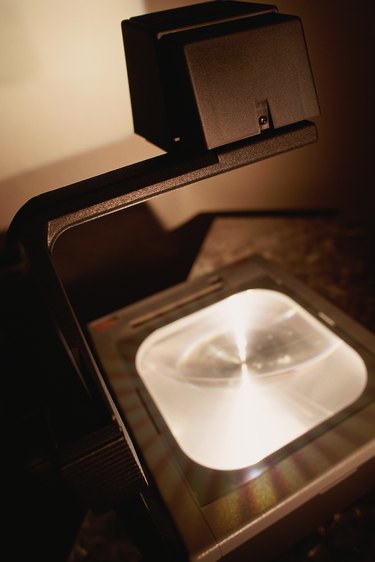
While overhead and data projectors are completely different devices in many ways, they essentially do the same thing. Both take a small image and blow it up for projection on a screen. Although data projectors have supplanted overhead projectors in most business settings, the easy interactivity that an overhead projector brings makes it useful for presentations that involve training or collaboration.
Construction
Video of the Day
Both types of projector use a bright lamp that shines through the material to be projected and is usually cooled by a fan. They also have a lens that takes the image and focuses it for projection onto a screen. In an overhead projector, the light shines through a glass on which you place a translucent slide. Data projectors have panels that display image signals sent from a computer or other video device.
Video of the Day
Lamp
The two devices use very different types of lamps, even though both are relatively small, bright and hot. Overhead projector lamps typically last less than 100 hours and cost well under $50. Data projector lamps usually cost hundreds of dollars and last thousands of hours. Both types of lamps almost always can put out more than 1,000 lumens of light, with most generating over 2,000. If anything, the overhead projection lamps are frequently brighter.
Media
Overhead projectors usually work with transparency slides. These are usually letter-sized sheets of transparent film that can be printed or marked on. Transparencies can be printed in full color and allow both permanent and erasable markers, but they're relatively fixed. After all, you can't un-print them in the middle of a presentation. Since data projectors present what gets sent to them, they have no limits on what you can project or how much you can change it. If your computer or other video sources can create it, a data projector can show it.
Interactivity
Data projectors can be extremely interactive if the presenter chooses to use them that way. However, many data projector presentations are relatively static presentations of slides from PowerPoint, Keynote or OpenOffice Impress. Overhead projectors, on the other hand, make interactivity easy since all that you have to do is write on the slide as it's being projected. You can even put a blank piece of film on the projector and use it as a gigantic whiteboard. Furthermore, you can determine the order of your presentation on the fly by reordering slides.